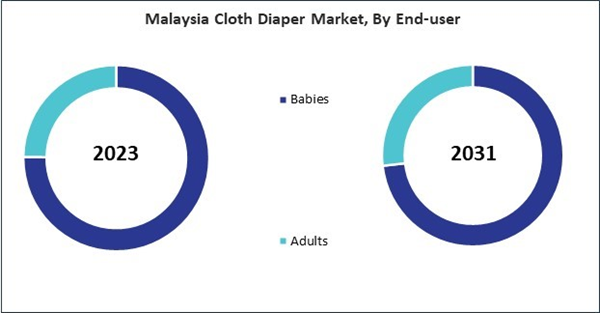The offline distribution channel in the cloth diaper market comprises physical retail outlets, specialty stores, and distribution networks that facilitate direct interactions between consumers and products. These brick-and-mortar establishments offer a hands-on shopping experience, allowing customers to see, touch, and evaluate cloth diaper options before making a purchase. Retailers in this channel often provide personalized assistance, product demonstrations, and educational resources to help customers choose the right cloth diapers for their needs. Therefore, in China,6.14 million units of cloth diapers were sold offline in 2023.
The China market dominated the Asia Pacific Cloth Diaper Market, By Country in 2023, and would continue to be a dominant market till 2031; thereby, achieving a market value of $763.4 Million by 2031. The Japan market is registering a CAGR of 10.8% during (2024 - 2031). Additionally, The India market would showcase a CAGR of 12.1% during (2024 - 2031).
The adoption of cloth diapers has seen a resurgence in recent years, driven by environmental concerns, health considerations, and economic benefits. Growing awareness of environmental issues, including waste generation and landfill pollution, has prompted many parents to seek eco-friendly alternatives to disposable diapers. Cloth diapers, which can be reused multiple times, offer a sustainable solution that reduces the environmental footprint associated with diapering.
Also, cloth diapers are often perceived as a more cost-effective option in the long run than disposable diapers. While the upfront investment in cloth diapers may be higher, their reusable nature means that parents can save money over time by avoiding the ongoing expense of purchasing disposable diapers regularly. Furthermore, modern advancements in cloth diapers have made them more user-friendly and convenient for parents. Features such as adjustable sizing, snap or hook-and-loop closures, and innovative absorbent materials make cloth diapers easier to use and maintain, appealing to busy parents looking for hassle-free diapering solutions.
A higher birth rate in China naturally leads to more infants needing diapers. This increase in the baby population boosts the overall demand for all types of diapers, including cloth diapers. China's mainland population increased to 1.4126 billion people at the end of 2021, according to the State Council of the People's Republic of China. Compared to the end of 2020, the most recent population estimate grew by 480,000. In 2021, there were 10.62 million babies born. Also, Chinese government initiatives to promote sustainable practices and reduce environmental pollution can influence consumer behavior. Policies encouraging eco-friendly products and practices can increase the adoption of cloth diapers.
Based on End-user, the market is segmented into Babies and Adults. Based on Distribution Channel, the market is segmented into Offline and Online. Based on countries, the market is segmented into China, Japan, India, South Korea, Singapore, Malaysia, and Rest of Asia Pacific.
List of Key Companies Profiled
- The Procter and Gamble Company
- Nicki’s Diapers, LLC
- Johnson & Johnson
- Bumpadum Manufacturing and Traders Private Limited
- bumGenius (Cotton Babies, Inc.)
- GroVia
- Kanga Care LLC
- Gerber Childrenswear LLC
- SuperBottoms (Navashya Consumer Products Pvt Ltd)
- Bumkins Finer Baby Products, Inc
Market Report Segmentation
By End-user (Volume, Thousand Units, USD Billion, 2020-2031)- Babies
- Adults
- Offline
- Online
- China
- Japan
- India
- South Korea
- Singapore
- Malaysia
- Rest of Asia Pacific
Table of Contents
Companies Mentioned
- The Procter and Gamble Company
- Nicki’s Diapers, LLC
- Johnson & Johnson
- Bumpadum Manufacturing and Traders Private Limited
- bumGenius (Cotton Babies, Inc.)
- GroVia
- Kanga Care LLC
- Gerber Childrenswear LLC
- SuperBottoms (Navashya Consumer Products Pvt Ltd)
- Bumkins Finer Baby Products, Inc









